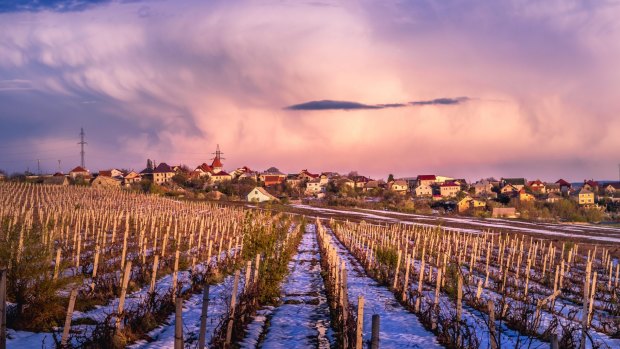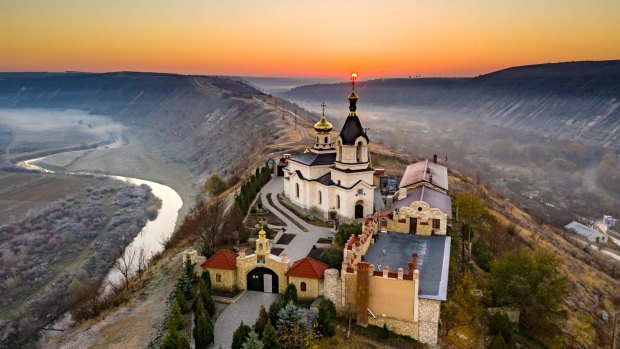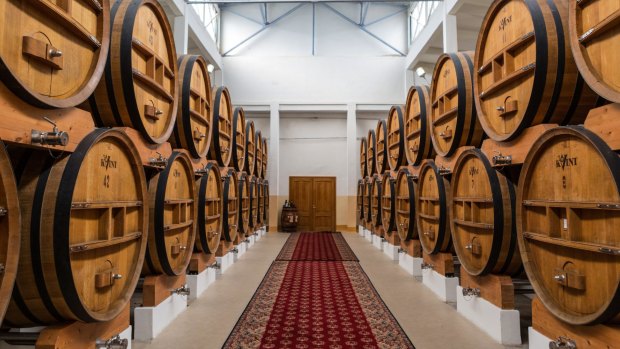This was published 4 years ago
Moldova things to do: Europe's new fine wines come from an unexpected place

A vineyard in snow, Chisinau, Moldova.Credit: Alamy
It's not every day you can sample some of Europe's finest wines, while simultaneously thumbing your nose at a certain Russian leader.
"Thank you Mr Putin," says Moldovan winemaker Dan Prisacaru, as we sample a 2015 Rosu Imparat made from a blend of locally grown rara neagra and feteasca neagra grapes. "Your wine embargoes have brought positive change to our wine industry."
Dan Prisacaru is part of a new wave of influential winemakers, who, in the aftermath of Russia's crippling 2006 and 2013 wine embargoes against Moldova, switched from making bulk wine for the Russian market to producing small-batch, quality wines to export to Western and central Europe, Japan, Singapore and Canada.

The Old Orhei monastery - part of an archaeological complex that's said to be the spiritual heart of Moldova.Credit: Shutterstock
It's early on a Friday evening and we're seated at Embargo, a wine bar on the ground floor of a boxy, Soviet-era apartment block in Chisinau, Moldova's capital. Located on Alexander Pushkin Street, named after the famous Russian poet who was exiled in Chisinau due to his social activism, the bar attracts a lively and eclectic crowd.
While Embargo is a sly dig at Russia's strong-armed tactics, the buzzing vibe and shelves of wines from 42 Moldovan wineries prove that this little nation is fighting back. "After the first embargo Moldova lost 60 per cent of its wine industry," says Prisacaru, "The wineries that survived were the ones that focused on producing premium wines."
If the bar's name illustrates the boldness of the current generation of winemakers, the labels tell the rest of the story. There are rows of cheeky Bad Boys, produced by Ion Luca from Carpe Diem winery, a parade of shady Individos, which translates as the "thirst for individuality", and Prisacaru's own label, Admir Lucrurile Aparent Imposibile, meaning "I admire things that seem impossible". The theme is at once humble and daring, a paradox I'm beginning to realise could stand for Moldova as a whole.

Tiny Moldova has been producing wines for 3000 years, making it one of the oldest wine cultures in the world.Credit: Intrepid
A puff of land wedged between Romania and Ukraine, tiny Moldova has been producing wines for 3000 years, making it one of the oldest wine cultures in the world. Under Soviet rule Moldova supplied almost 70 per cent of the USSR's wines, a relationship that continued well after the fall of communism in 1991.
The sour grapes began when the independent Republic of Moldova began looking towards the west for EU membership, an infraction so severe that Russia retaliated by imposing a series of import bans on Moldovan wines.
Sensing liberation rather than loss a small group of winemakers formed an association and started experimenting with European varietals blended with indigenous varieties. Prisacaru himself returned from Burgundy in 2013, where he'd been studying winemaking, to start his own winery, Minis Terrios, a name meaning "small plots".
Over the course of the evening we sample everything from a sparkling crisecco (similar to Italy's famous prosecco) to a crisp sauvignon blanc, a ruby-coloured 2016 Bad Boys to a 2013 ice wine riesling from Chateau Vartely. On a similar latitude to Burgundy, with rich soils overlying limestone and sunny slopes, winemaking is in Moldova's DNA.
While the wines are exceptionally good and the prices wallet-friendly (from €3 for a bottle of the crisecco to €16 for the ice wine) the real joy is the sense of being at the edge of a seismic shift. It feels a little risky, rebellious even.
It's day five of my 13-day journey from Bucharest to Kiev travelling through Romania, Moldova and Ukraine with Intrepid Travel. We are a small group of curious travellers from Australia, Britain and the US, all keen to sidestep the well-worn European trail.
Our introduction to Moldova begins in Comrat, the capital of the Autonomous Territorial Unit of Gagauzia, a tiny corner of Moldova that was granted special legal status in 1994. Comprising three cities and 23 communes, the people of Gagauzia are Turkic-speaking people, believed to be descendants of Seljuk Turks who migrated here in the 13th century.
Finding a secret pocket in one of the least-visited countries in Europe is as whimsical as finding a magic door to a Faraway Tree, albeit with a faded Soviet twist. With eyes on stalks we take in everything from victory monuments to belching Lada cars, scowling Lenin statues to a canary-yellow cathedral.
A two-hour drive brings us to Chisinau, a city where Stalin-style architecture meets old-world charm meets a burgeoning wine scene. In the company of Dan Prisacaru we learn just how passionate Moldovans are about their vines. "Since 2006 our government has classified wine as a food product rather than an alcoholic beverage," says Prisacaru.
After a night at Hotel Chisinau, complete with lumpy beds and rusty Russian bar fridges that haven't worked since Putin came to power, we head to Milestii Mici wine cellars. Our drive takes us through fields carpeted in sunflowers and alongside avenues of walnut trees. We pass farmers driving horse-drawn carts and wave to women tilling corrugated rows of rich soil. If Chisinau is all Soviet Empire, the countryside is pure Middle Ages.
From bucolic bliss we are thrust 80 metres below into the strange subterranean world of Milestii Mici, home to the world's largest wine collection with 1.5 million bottles of wine spread across 200 kilometres of underground tunnels – with the Guinness World Record to prove it.
The state-run cellar was constructed from an old limestone mine, the temperature and consistent humidity offering perfect storage conditions. Unlike regular wine cellars we don't walk but drive, headlights on, wending our way through streets called Sauvignon or Pinot, many lined with prized vintages and bottles of sparkling wine still turned by hand. We pass a natural waterfall, a seismic station for measuring earthquakes and a street where you can rent a cell for your personal collection.
We learn that Vladimir Putin however prefers to keep his stash at Cricova, the world's second largest cellar, also in Moldova, 15 kilometres north of Chisinau. "It's so vast that cosmonaut Yuri Gagarin got lost inside for two days," says our guide Doreen. After the one-hour tour we are treated to a tasting session of three wines – a dry sauvignon blanc, a smooth 2012 merlot and a sticky 2005 dessert wine. As delightful as these are, these state-owned bottles lack the spirit of the wines we had tasted at Embargo.
On our final evening in Chisinau I buy a bottle of Carpe Diem's 2016 Bad Boys, the cheeky faces of the two men on the label and the message "seize the day" impossible to resist. The independent Republic of Moldova may only be 28 years old, yet, is making bold advances towards a brighter, wine-driven future.
FIVE OTHER WAYS TO ENJOY MOLDOVA
1. Share a meal with a local family. Restaurants are unknown in rural areas, so some families open their kitchens to visitors.
2. Explore Old Orhei, an archaeological complex 60 kilometres north-east of Chisinau, said to be the spiritual heart of Moldova.
3. Visit Chisinau's open-air Central Markets for fresh fruit and vegetables, bread, wine, cheese and dried nuts. Strada Ismail, Chisinau.
4. Spend an afternoon in Chisinau's Stefan cel Mare Park, Moldova's oldest park with an avenue dedicated to literary greats.
5. Visit the Assumption of the Virgin Mary, Moldova's oldest wooden church from 1642. Dacia Boulevard, Chisinau.
TRIP NOTES
MORE
TOUR
Intrepid Travel's 13-day Moldova, Ukraine and Romanian Explorer, starting in Bucharest, costs from $3080 a person, twin share. See intrepidtravel.com
FLY
Emirates flies from Sydney and Melbourne to Bucharest, Romania, via Dubai. See emirates.com.
Kerry van der Jagt was a guest of Intrepid Travel intrepidtravel.com
Sign up for the Traveller Deals newsletter
Get exclusive travel deals delivered straight to your inbox. Sign up now.